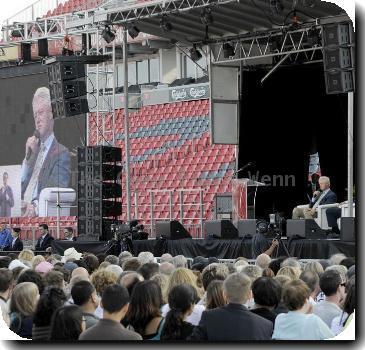Monks, tourists, villagers gather on beaches to mark 5 years since Asia tsunami killed 230,000
By Jocelyn Gecker, APSaturday, December 26, 2009
Monks, tourists, villagers mark Asian tsunami
PHUKET, Thailand — Buddhist monks in orange robes chanted on a Thai beach, an Indonesian mother mourned her children at a mass grave, and a man scattered flowers in now-placid waters Saturday to commemorate the 230,000 killed five years ago when a tsunami ripped across Asia.
An outpouring of aid that followed the Dec. 26, 2004, tsunami has helped replace homes, schools and entire coastal communities decimated by the disaster. But at Saturday’s ceremonies, survivors spoke of the enduring wounds.
Thousands in Indonesia’s Aceh province, which was hardest hit, held prayer services at mosques and beside the mass graves where tens of thousands were buried. The 167,000 people who died in Indonesia accounted for more than half the total death toll.
Among them were the relatives of Siti Amridar, a 48-year-old woman who wept Saturday at a mass grave in Banda Aceh, the provincial capital. She was a mother of five, until the tsunami claimed four of her children, her parents and washed away their village.
“I don’t know where my children have been buried, or my parents. They have never been found,” she said, sobbing. “I still can’t believe the tsunami destroyed my life and my family in just a few minutes.”
The disaster’s epicenter was off the coast of Aceh, on the island of Sumatra, where a 9.2-magnitude earthquake struck underwater. The quake toppled homes and buildings and sent panicked communities rushing into the streets.
About 20 minutes later, a wall of water up to six stories high surged in from the sea. Traveling at jetliner speed, it carried with it toppled trees, crumpled cars and refrigerators. The wave sent people scrambling up the sides of buildings and in search of higher ground.
On Saturday’s anniversary, Indonesian villagers briefly panicked when another strong earthquake struck deep under the sea off the eastern coast, officials said. Residents in Saumlaki, about 1,680 miles (2,700 kilometers) east of the capital Jakarta, said the magnitude-6.0 quake cut electricity, but there were no reports of damage or injuries.
Indonesia sits above a series of fault lines that make the vast island nation one of the most earthquake-prone places in the world. This year, another earthquake measuring magnitude 7.6 struck off West Sumatra on Sept. 30, killing hundreds of people and toppling hundreds of homes and buildings.
In Thailand on Saturday, hundreds of residents and foreigners returned to the white-sand beaches on the southern island of Phuket. More than 8,000 people were killed along the country’s shores.
A moment of silence was observed on the Phuket’s Patong Beach, a popular strip of hotels and restaurants, where the waves crashed over throngs of tourists the morning after Christmas.
Buddhist monks in bright orange robes chanted prayers. Onlookers wept and embraced.
Giorgio Capriccioli, an Italian who lives on Phuket, carried a bouquet into the ocean.
He waded knee-deep in water that five years ago was clogged with corpses and cast the white flowers adrift to honor the memory of two friends. His wife owns several beach-front shops but decided not to go to work the morning the tsunami struck.
“My wife would be dead if it weren’t for the fact that she were pregnant and didn’t go to work that day,” he said at a ceremony that attracted suntanned tourists in skimpy swimsuits as well as Thai villagers.
The commemorations on Phuket culminated in the evening with the release of hundreds of light-filled lanterns into the sky.
Traffic across Sri Lanka came to a standstill Saturday as people around the country observed two minutes of silence for the 35,000 people who died there.
A ceremony was held at the southern coastal village of Peraliya, where the waves mangled a passing train and killed hundreds of passengers. At the site of the wreckage, which was one of the most enduring images of disaster, relatives of the dead lit candles and placed flowers where a monument now stands.
“The tsunami ruined our lives, killed our loved ones. That tragedy changed our lives forever,” said S.A. Dayawathi, 62, who on the train and knocked unconscious when it crashed. She awoke to find herself buried beneath corpses and later learned two family members had perished.
More than $13 billion in aid money poured in from around the world, nearly half for Aceh.
Former U.S. President Bill Clinton, who served as a U.N. special envoy for tsunami recovery, said the money went to historically poor and ignored areas.
“We did more than just build back; we built back better. … Though some tsunami-affected areas have not fully recovered, the recovery process continues, and governments, communities, and people around the region are better prepared for the future,” he said in a statement released Saturday by the Clinton Foundation.
A huge reconstruction effort has now rebuilt Aceh, providing more than 140,000 new homes, 2,227 miles (3,585 kilometers) of roads, 1,500 schools and 1,047 hospitals. Still the work is not finished: More than 2,000 people still live in shelters.
“After five years … the people of Aceh have risen and have a new life,” Indonesia’s Vice President Boediono told a crowd gathered near Ulee Lheue port in Aceh. Like many Indonesians, he uses only one name
Gecker reported from Bangkok. Associated Press writers Fakhrurradzie Gade in Banda Aceh, Indonesia, Eranga Jayawardena in Peraliya, Sri Lanka, Bharatha Mallawarachi in Colombo, Sri Lanka, and Edith M. Lederer at the United Nations also contributed to this report.
Tags: Accidents, Aceh, Asia, Bill Clinton, Christmas, Indonesia, Phuket, Plants, South Asia, Southeast Asia, Sri Lanka, Sumatra, Thailand



